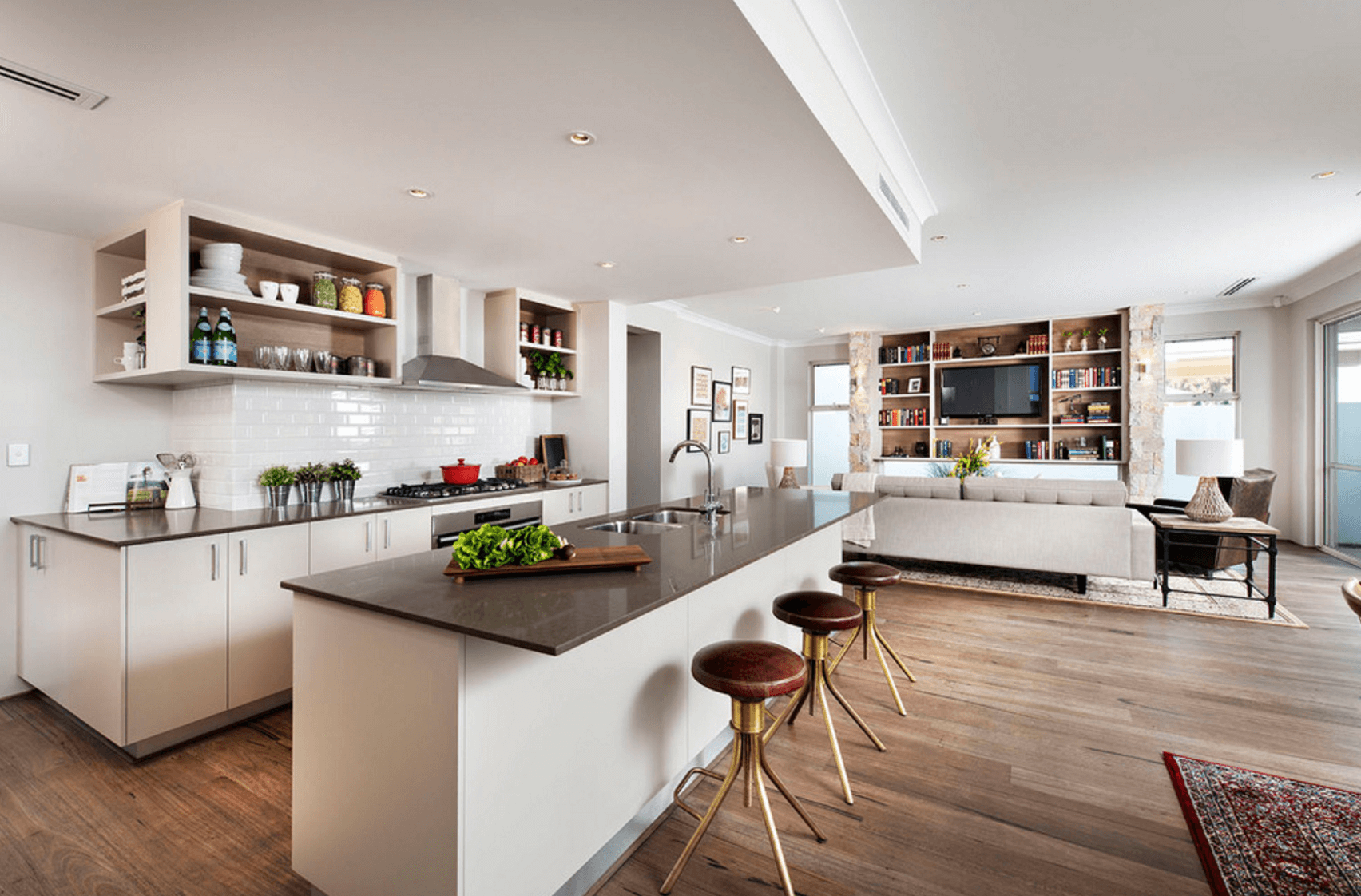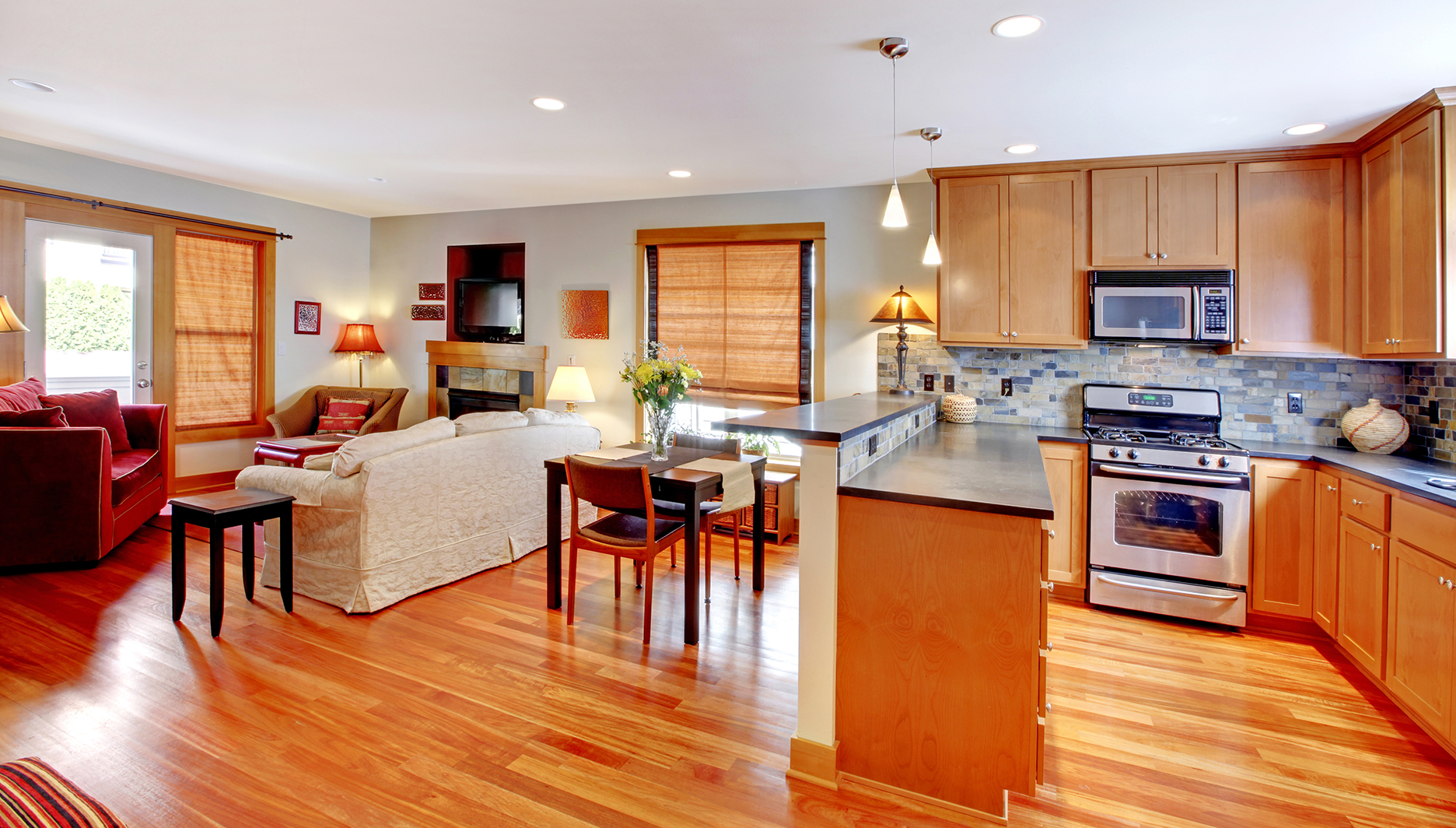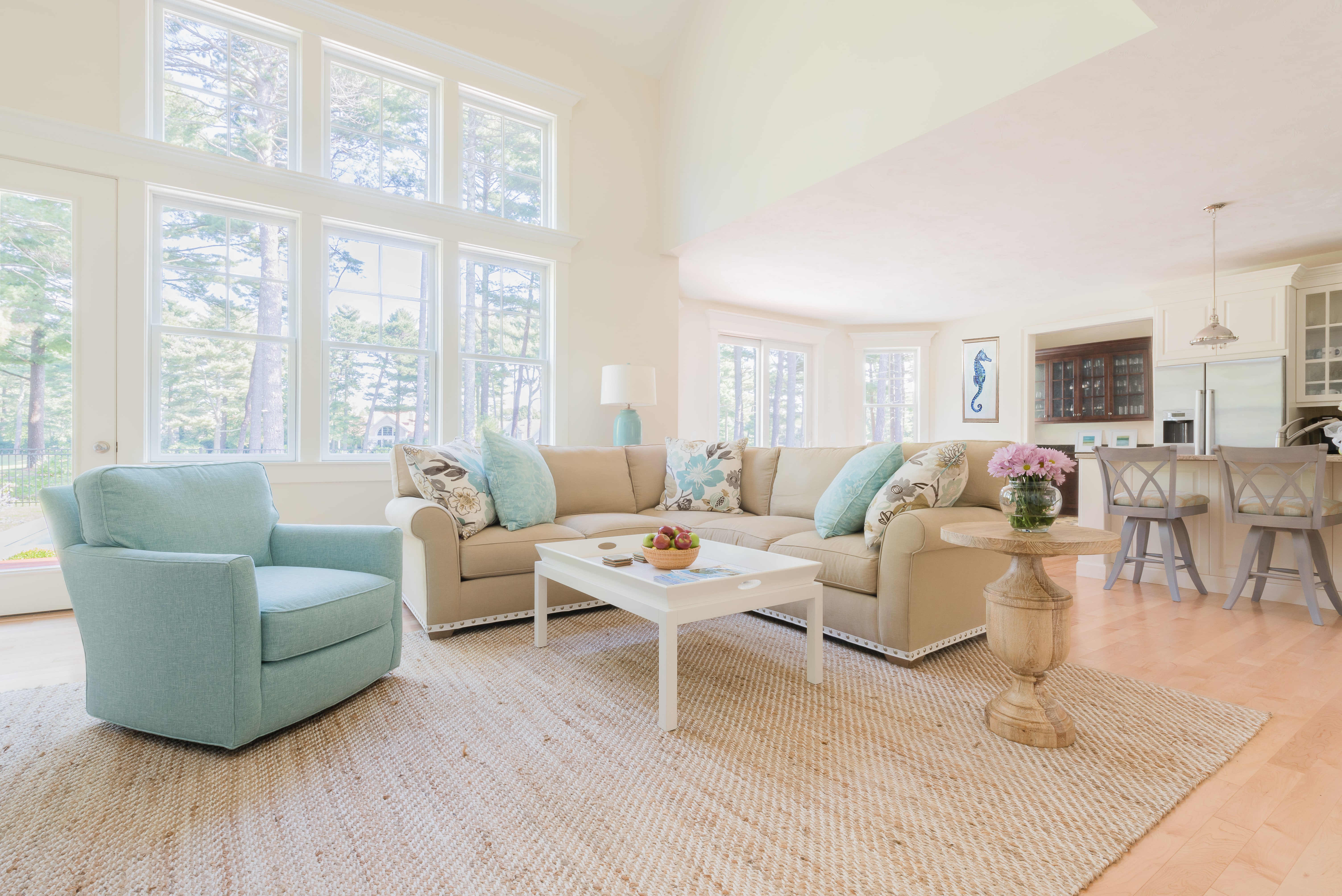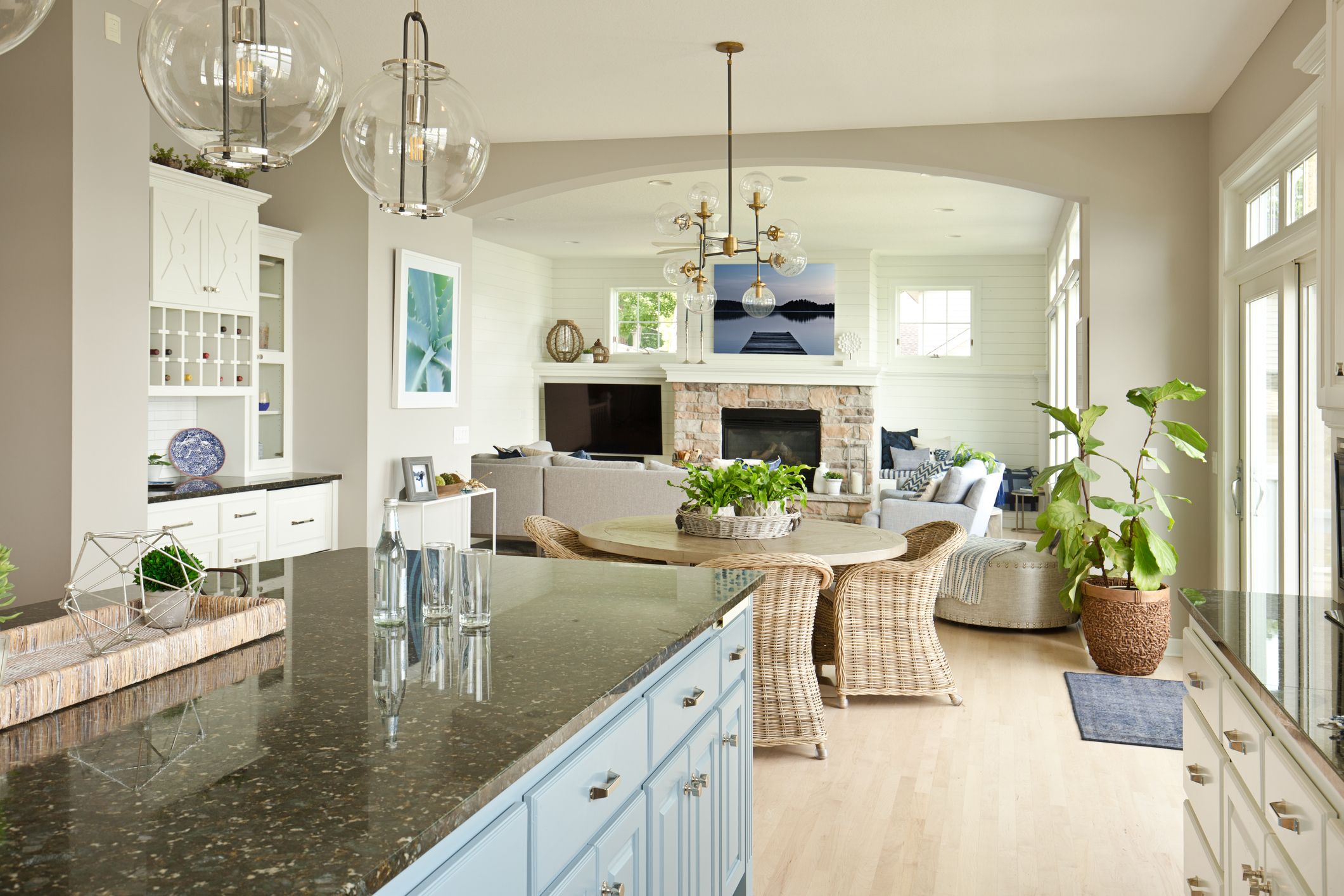Two-Story Open Concept: Kitchen & Living Room Bliss
Two-Story Open Concept: Kitchen & Living Room Bliss
The open concept floor plan has taken the design world by storm, and for good reason. It fosters a sense of spaciousness, encourages seamless flow, and promotes a feeling of connection between different areas of the home. While open concept kitchens and dining rooms are a common sight, the two-story open concept takes this trend to new heights, offering an unparalleled experience of grandeur and functionality.
This article explores the captivating allure of a two-story open concept living room and kitchen, delving into its unique benefits, design considerations, and how to achieve a truly harmonious and breathtaking space.
The Allure of the Two-Story Open Concept
The two-story open concept, often seen in modern homes, offers a distinctive combination of visual impact and functional advantages. Here's why it's gaining popularity:
1. A Sense of Grandeur: The sheer scale of a two-story open space is inherently impressive. It creates a feeling of expansiveness, drawing the eye upwards and emphasizing the home's verticality. The open staircase, often a focal point in such designs, adds to the drama and architectural interest.
2. Enhanced Natural Light: With high ceilings and large windows, a two-story open concept maximizes natural light penetration. This not only makes the space feel brighter and more inviting but also reduces the need for artificial lighting during the day.
3. Improved Flow and Connectivity: The seamless flow between the living room and kitchen fosters a sense of togetherness. It's ideal for entertaining guests, allowing for easy conversation and interaction while cooking or enjoying meals. It also makes the space more practical for daily life, eliminating the need for constant movement between separate rooms.
4. Versatility and Flexibility: The open concept allows for a high degree of personalization. It can be adapted to suit various lifestyles and needs, accommodating both formal gatherings and casual family evenings. The flexibility of the space makes it easy to rearrange furniture and adapt to changing needs over time.
Design Considerations for a Two-Story Open Concept
While the allure of a two-story open concept is undeniable, careful planning is essential to avoid common pitfalls. Here are some crucial design considerations:
1. Defining Spaces without Walls: While open spaces are desirable, they should not feel cluttered or chaotic. Consider using strategic elements to define different areas within the open concept:
* **Furniture Placement:** Use furniture strategically to create distinct zones. For instance, a large sofa and coffee table can define a living room area, while a dining table and chairs designate the dining space.
* **Rugs:** Different area rugs can visually separate zones within the open plan, defining each space and creating a cohesive flow.
* **Lighting:** Varying light fixtures and their placement can help to emphasize different areas within the space. A chandelier over the dining table can create a focal point, while recessed lighting can illuminate the kitchen countertop area.
* **Ceiling Treatments:** A **vaulted ceiling** or a **tray ceiling** with different treatments can add visual interest and help to define areas.
* **Color and Material:** Utilizing different color palettes and materials can also differentiate zones. For instance, a warm color palette in the living room can contrast with a cooler, more functional color scheme in the kitchen.
2. Acoustics and Noise Control: The open design can amplify noise, especially in the case of a two-story space. It's crucial to address this potential challenge early in the design process:
* **Sound-Absorbing Materials:** Incorporate **sound-absorbing materials** such as carpets, curtains, and rugs to soften noise levels.
* **Furniture Placement:** Strategic furniture placement can also act as a natural barrier to sound.
* **Area Rugs:** Thick rugs can absorb sound and create a more intimate ambiance.
* **Ceiling Treatments:** Using acoustic panels in the ceiling can effectively minimize noise reverberation.
3. Visual Continuity: To ensure a cohesive design, consider visual continuity when choosing finishes, colors, and textures:
* **Color Palette:** Choose a cohesive color palette that ties together the different areas of the space.
* **Material Continuity:** Use similar materials in the kitchen, dining room, and living room, such as hardwood floors or stone countertops, to create a harmonious visual flow.
* **Lighting Scheme:** Ensure that the lighting scheme complements the overall design and provides adequate light for each area.
4. Staircase Design and Placement: The staircase is a central element in a two-story open concept and should be designed to enhance the space's flow and aesthetic appeal:
* **Open or Closed Stairs:** An open staircase can create a sense of airiness and visual connection, while a closed staircase can provide more privacy and sound insulation.
* **Staircase Material:** Choose a staircase material that complements the overall design aesthetic and blends seamlessly with the surrounding space.

* **Staircase Location:** Strategic placement of the staircase can maximize visual impact and optimize space utilization.
5. Kitchen Design and Functionality: In a two-story open concept, the kitchen is often the heart of the home. Design it for optimal functionality:
* **Island or Peninsula:** An island or peninsula can provide additional workspace, seating, and storage.

* **Cabinetry:** Choose cabinets that offer ample storage and complement the overall design aesthetic.
* **Appliances:** Select appliances that are efficient, stylish, and meet your specific needs.
* **Backsplash and Countertop:** Consider a backsplash and countertop that are durable, easy to clean, and visually appealing.

6. Living Room Layout and Furnishings: The living room is where you will relax and entertain. Choose furnishings that are comfortable, stylish, and complement the overall design:
* **Seating:** Provide ample seating for guests and family members.
* **Coffee Table:** A functional coffee table is a must-have for a living room.

* **Entertainment System:** Consider a home theater system or a media center to enhance the entertainment experience.
* **Decorative Accents:** Add decorative accents such as throw pillows, artwork, and plants to personalize the space.
Creating a Cohesive Two-Story Open Concept

A successful two-story open concept is more than just a large space. It's a harmonious blend of function and form, where each element complements the others to create a truly breathtaking living experience. Here's how to achieve this:
1. Define a Consistent Design Style: Establish a clear design aesthetic for the entire space. Whether it's modern, contemporary, traditional, or rustic, a cohesive style will ensure visual harmony.
2. Use a Unified Color Palette: Create a unified color palette that ties together the different areas of the space. Choose a base color and accent colors that complement each other and create visual interest.

3. Incorporate Natural Materials: Use natural materials such as wood, stone, and leather to bring warmth and texture to the space. These materials also enhance the room's acoustical properties.
4. Embrace Ample Natural Light: Maximize natural light by using large windows and skylights. This will create a brighter, more inviting atmosphere.
5. Don't Forget the Details: Pay attention to the details, such as door hardware, light fixtures, and window treatments. These elements can elevate the design and create a polished look.

6. Focus on Functionality: Ensure that the space is functional and meets your family's needs. Consider traffic flow, storage needs, and the overall layout.
7. Create a Focal Point: Identify a focal point in the space, such as a fireplace, a large piece of artwork, or a dramatic staircase. This will draw the eye and create a sense of visual interest.
The Benefits of a Two-Story Open Concept

Beyond its visual impact, a two-story open concept offers numerous benefits:
1. Enhanced Family Connection: The open concept encourages interaction between family members, fostering a sense of togetherness and promoting communication.
2. Flexibility for Entertaining: The spacious layout provides ample room for entertaining guests, allowing for easy movement and flow during parties and gatherings.

3. Natural Light and Airiness: The high ceilings and large windows create a bright and airy atmosphere, making the home feel more spacious and welcoming.
4. Increased Home Value: A two-story open concept is a desirable feature that can increase a home's value and make it more appealing to potential buyers.
Conclusion

A two-story open concept living room and kitchen is more than just a design trend. It's a testament to the power of design to create a space that's both beautiful and functional, maximizing the use of space while promoting connection and enhancing the quality of life. With careful planning and a focus on both aesthetic and practical considerations, a two-story open concept can transform your home into a truly captivating and inspiring sanctuary.
Open Concept Bliss: Living Large in a 2-Story Kitchen & Living Room

The open-concept design has taken the world of interior design by storm, seamlessly blurring the lines between once-distinct spaces. In this trend, the kitchen and living room often merge into one expansive area, creating a dynamic and inviting atmosphere. But when you introduce a second story, the possibilities truly take flight. This blog post explores the unique advantages and considerations of living in a two-story open-concept kitchen and living room, and helps you navigate the design challenges and embrace the full potential of this architectural masterpiece.
The Allure of Open-Concept Living
Before delving into the specifics of a two-story space, let's first appreciate the core principles of open-concept living. This design philosophy is rooted in the idea of:

- Enhanced Flow and Connection: The absence of walls fosters a natural flow between spaces, making it easier to move between the kitchen, dining area, and living room. This seamless connection creates a sense of spaciousness and encourages social interaction.
- Maximized Natural Light: Open floor plans allow light to flood the entire space, brightening the rooms and creating a welcoming ambiance.
- Flexible Functionality: The open layout provides flexibility in furniture placement and allows you to create distinct zones for different activities within the same space.
The Two-Story Advantage
While a single-story open-concept kitchen and living room offers undeniable benefits, adding a second story elevates the experience to a whole new level. This design choice introduces several unique advantages:

- Dramatic Height and Visual Impact: The added height creates a sense of grandeur and openness, making the space feel even larger and more inviting. The vertical element also adds visual interest and depth.
- Enhanced Views and Light: With a second story, the kitchen and living room can be positioned to take advantage of stunning views and maximize natural light. Imagine waking up to panoramic city views from your kitchen or enjoying the sunset from your living room!
- Creative Architectural Opportunities: The two-story design allows for creative architectural details like a double-height fireplace, a floating staircase, or a skylight, creating a visually stunning focal point.
Navigating the Challenges
While the open-concept two-story space offers many perks, it also presents unique challenges that you need to address thoughtfully.

- Sound Control: The lack of physical barriers can lead to sound amplification, potentially making it difficult to have quiet conversations or enjoy moments of peace. Soundproofing techniques are crucial in a two-story open space. Consider using acoustical panels, thick rugs, and sound-absorbing furniture to minimize noise travel.
- Temperature Control: The open layout can make it harder to maintain consistent temperatures throughout the entire space, especially in areas with significant temperature fluctuations. Strategically placed air conditioning units and efficient heating systems can help address this concern.
- Visual Clutter: An open space can easily become cluttered if not carefully planned. Consider incorporating storage solutions, choosing furniture with built-in storage, and adopting minimalist décor to maintain a clean and organized look.
Designing Your Two-Story Dream:
Here are some key design elements to consider when creating your two-story open-concept kitchen and living room:

-
Kitchen Design:
- Island as a Focal Point: An island serves as a natural divider between the kitchen and living room, offering both practicality and style. Choose an island with ample storage and countertop space to maximize functionality.
- Open Shelving: Open shelving adds visual interest and helps to create a cohesive flow between the kitchen and living room. Choose decorative pieces that complement your design style.
- Integrated Appliances: Blending appliances seamlessly into the kitchen design, like a built-in refrigerator or a flush-mount microwave, enhances the overall aesthetic and minimizes visual clutter.
-
Living Room Design:

* **Comfortable Seating:** Choose comfortable and stylish seating options that encourage gathering and conversation. Consider a large sectional sofa or a collection of individual armchairs.
* **Area Rugs:** Area rugs help define different zones within the open space and add a touch of warmth and personality.
* **Focal Point:** Create a focal point in the living room with a **dramatic fireplace**, a **statement piece of art**, or a **well-designed bookshelf**.
-
Staircase as a Feature:
- Floating Staircase: A floating staircase, suspended from the ceiling, adds a touch of contemporary elegance and minimizes the visual impact of the stairs.
- Open Railings: Open railings enhance the airy feel of the space and allow light to flow freely.
- Built-in Storage: Consider incorporating storage spaces into the staircase design, such as drawers or shelves, to maximize efficiency.

-
Lighting Strategies:
- Layered Lighting: Combine overhead lighting with accent lighting to create a warm and inviting ambiance. Use pendant lights over the kitchen island, recessed lights in the ceiling, and sconces on the walls for a balanced approach.
- Natural Light Maximization: Use large windows to allow natural light to flood the space. Consider incorporating skylights to bring light into the second floor and create a sense of openness.
Embracing the Two-Story Lifestyle

Living in a two-story open-concept kitchen and living room is more than just a design choice; it's a lifestyle. This unique space fosters a sense of community and allows you to enjoy the full potential of your home:
- Entertaining Made Easy: The seamless flow between spaces makes hosting gatherings and parties a breeze. Guests can easily move between the kitchen and living room, while the open layout encourages conversation and interaction.
- Family-Friendly Environment: The open-concept space creates a welcoming and inviting atmosphere for families to gather, play, and connect. Children can play in the living room while adults prepare meals in the kitchen, fostering a sense of togetherness.
- Flexibility for Different Needs: The open layout allows you to customize the space to suit your changing needs. Whether you need a quiet space for work, a dedicated play area for children, or a cozy reading nook, the flexible nature of the open-concept design allows you to adapt the space to your preferences.
Conclusion:


Living in a two-story open-concept kitchen and living room offers a unique and rewarding experience. The grandeur, openness, and flexibility of this architectural design create a dynamic and welcoming space for modern living. By carefully considering the challenges and embracing the design opportunities, you can transform this unique space into the heart of your home, a place where family and friends can connect, create memories, and enjoy the beauty of open-concept living. .
